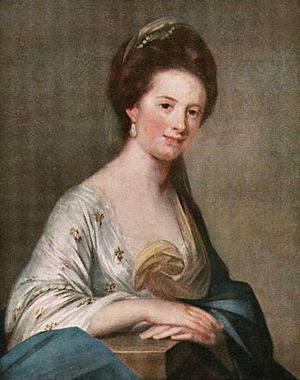Mary Hay, 14th Countess of Erroll facts for kids
Quick facts for kids
The Countess of Erroll
|
|
|---|---|

Painting of Lady Erroll, by Francis Cotes
|
|
| Personal details | |
| Born |
Mary Hay
|
| Died | 19 August 1758 Slains Castle, Aberdeen |
| Spouse |
Alexander Falconer
(m. 1722) |
| Parents | John Hay, 12th Earl of Erroll Lady Anne Drummond |
| Relatives | Charles Hay, 13th Earl of Erroll (brother) |
Mary Hay, the 14th Countess of Erroll (who passed away on August 19, 1758), was an important Scottish noblewoman. She held the title of Countess of Erroll in her own right, meaning she inherited it directly.
She was also the 18th Hereditary Lord High Constable and Knight Marischal of Scotland. These were very important roles! The Lord High Constable was the most senior officer among the Royal Officers of Scotland. This person was also the Chief of the King's Household in Scotland. Mary inherited these special titles in 1717 when her brother, Charles Hay, 13th Earl of Erroll, passed away without marrying.
Contents
Early Life and Family
Mary Hay was the oldest daughter of John Hay, 12th Earl of Erroll. Her mother was Lady Anne Drummond. Lady Anne was the sister of the Jacobite Dukes of Perth and Melfort.
Mary had an older brother named Charles Hay, 13th Earl of Erroll. She also had a younger sister, Lady Margaret Hay. Lady Margaret later married James Livingston, 5th Earl of Linlithgow.
Like her brothers, Countess Mary supported the Jacobite cause. This meant she secretly supported the exiled King James Francis Edward Stuart. He was also known as the "Old Pretender." His court was in France, at Saint Germain-en-Laye.
Countess of Erroll's Role
Mary's older brother was held in Edinburgh Castle. He was suspected of working against the king. He lived outside Scotland from 1712 to 1715. As the oldest sister, Mary was next in line to inherit the family titles. She officially became his heir on February 6, 1718.
She was allowed to claim her role as High Constable. This happened at the coronation of King George II of Great Britain. Even though she was a woman, she could have someone represent her.
Supporting the Jacobite Cause
In 1745, Mary Hay gathered a group of men from Buchan. They supported Prince Charles Edward Stuart, also known as "Bonnie Prince Charlie." He was trying to reclaim the throne.
Mary used Slains Castle as a secret meeting place. It was a main spot for Jacobite agents to land. She even had a secret agreement with a naval officer. He would let her know when his ship was near Slains. Once the agents landed, they were quickly moved inland. They went to another of her strongholds, Delgatie Castle. This castle had hidden rooms and secret passages.
Mary also used a person named Jamie Fleeman as a messenger. He was known as the Laird of Udny's fool. Because of this, he could travel around the countryside without being questioned. This made him perfect for contacting Jacobite rebels in hiding.
In 1747, a new law was passed. It was called the Heritable Jurisdictions (Scotland) Act 1746. This law removed certain old family powers. Mary received £1,200 for the special legal rights of Slains.
Personal Life and Legacy
Before August 1722, Mary Hay married Alexander Falconer of Delgaty. He was a lawyer and the son of Sir David Falconer. Sir David was a very important judge. Alexander later took the Hay family name.
Her husband passed away in July 1745. Mary herself died on August 19, 1758, at Slains Castle. She did not have any children. Because of this, the family titles went to her great-nephew. This was James, Lord Boyd. He was the grandson of Mary's sister, Lady Margaret Hay. James's father, William Boyd, 4th Earl of Kilmarnock, faced serious consequences in 1746. This was because of his involvement in the Jacobite rising of 1745.
Images for kids
-
Ruins of Slains Castle


